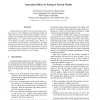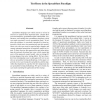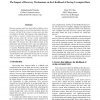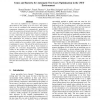123
Voted
ISSRE
2002
IEEE
15 years 5 months ago
2002
IEEE
An important aspect of developing models relating the number and type of faults in a software system to a set of structural measurement is defining what constitutes a fault. By de...
ISSRE
2002
IEEE
15 years 5 months ago
2002
IEEE
Formal analysis of software is a powerful analysis tool, but can be too costly. Random search of formal models can reduce that cost, but is theoretically incomplete. However, rand...
92
Voted
ISSRE
2002
IEEE
15 years 5 months ago
2002
IEEE
Software Fault Tree Analysis (SFTA) provides a structured way to reason about the safety or reliability of a software system. As such, SFTA is widely used in missioncritical appli...
ISSRE
2002
IEEE
15 years 5 months ago
2002
IEEE
Spreadsheet languages are widely used by a variety of end users to perform many important tasks. Despite their perceived simplicity, spreadsheets often contain faults. Furthermore...
112
click to vote
ISSRE
2002
IEEE
15 years 5 months ago
2002
IEEE
Improving the dependability of computer systems is increasingly important as more and more of our lives depend on the availability of such systems. Wrapping dynamic link libraries...
86
Voted
ISSRE
2002
IEEE
15 years 5 months ago
2002
IEEE
Recovery systems must save state before a failure occurs to enable the system to recover from the failure. However, recovery will fail if the recovery system saves any state corru...
ISSRE
2002
IEEE
15 years 5 months ago
2002
IEEE
We report a study to determine the impact of four types of disturbances on the failure intensity of a software product undergoing system test. Hardware failures, discovery of a cr...
100
click to vote
ISSRE
2002
IEEE
15 years 5 months ago
2002
IEEE
Tracing is a dynamic analysis technique to continuously capture events of interest on a running program. The occurrence of a statement, the invocation of a function, and the trigg...
94
Voted
ISSRE
2002
IEEE
15 years 5 months ago
2002
IEEE
In this paper we extend an earlier worst case bound reliability theory to derive a worst case reliability function R(t), which gives the worst case probability of surviving a furt...




